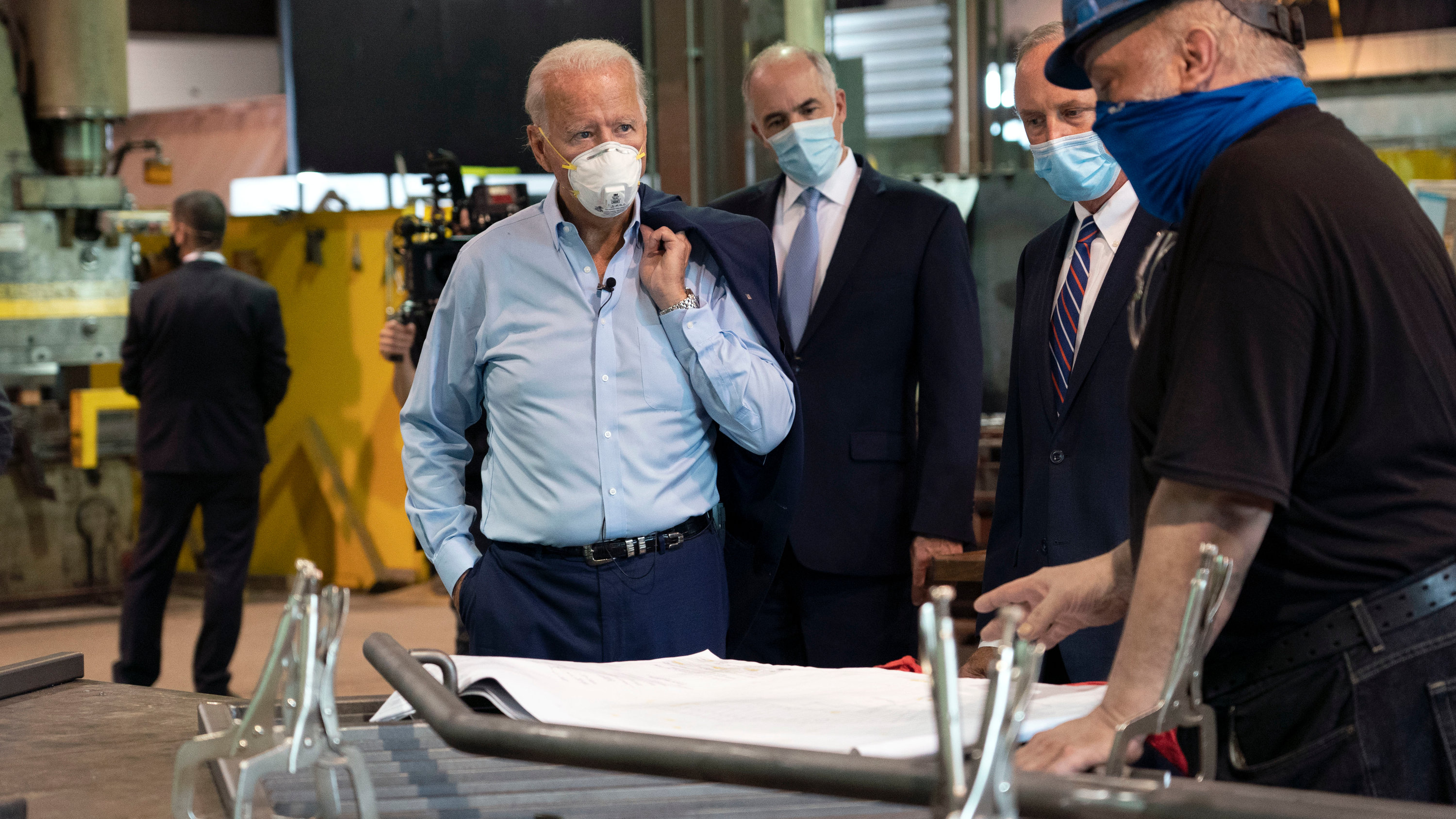Advertisement
Joseph R. Biden Jr. laid out a populist economic vision with the tagline “Build Back Better,” part of an effort to confront President Trump on his strongest issue in polling.
transcript
0:00/1:16
-0:00
transcript
At a campaign event in Pennsylvania, Joseph R. Biden Jr., the presumptive Democratic presidential nominee, described his plan for strengthening the economy.
-
So enough is enough. It’s time to reverse the priorities in this country. It’s time to help small businesses, middle-class folks, manage their way through a pandemic. Let’s help millions of would-be entrepreneurs get out from under their debt so they can start businesses. And it’s time corporate America paid their fair share of taxes. We thought in our administration, we should lower the tax in the high 30s to 28 percent — lowered it to 21. I’m going to raise it back up to 28. Provide hundreds of billions of dollars to invest in the growth of this country. And the days of Amazon paying nothing in federal income tax will be over. Let’s make sure that our workers have the power and the voice. It’s way past time to put an end to the era of shareholder capitalism. The idea that the only responsibility a corporation has is to its shareholders. That’s simply not true, it’s an absolute farce. They have a responsibility to their workers, their communities and their country.

Joseph R. Biden Jr. laid out a populist economic vision to revive and reinvest in American manufacturing on Thursday, calling for major new spending and stricter new rules to “Buy American” as part of an effort to more aggressively challenge President Trump on two of his signature issues: the economy and nationalism.
In a speech in the battleground state of Pennsylvania, Mr. Biden lacerated Mr. Trump for a bungled response to the coronavirus pandemic that has deepened the economic crisis and a misplaced focus on the stock market, while framing his own economic agenda around a new campaign tagline, “Build Back Better.”
In some ways, Mr. Biden was seizing the “Buy American” message from Mr. Trump himself, who campaigned on an “America First” agenda in 2016 and wrote on Twitter on his Inauguration Day that “Buy American” and “Hire American” were “two simple rules” that would guide his administration.
Mr. Biden said his plans would leverage trade, tax and investment policy to spur domestic innovation, reduce the reliance on foreign manufacturing and create five million additional American manufacturing and innovation jobs.
“I do not buy for one second that the vitality of American manufacturing is a thing of the past,” Mr. Biden said, speaking at a metalworks factory in Dunmore not far from his childhood home of Scranton, a place where Mr. Biden often returns rhetorically to emphasize his blue-collar roots.
“When the federal government spends taxpayers’ money, we should use it to buy American products and support American jobs,” he added.
On the same day, Vice President Mike Pence embarked on a Trump campaign bus tour across Pennsylvania, a sign of the state’s significance in the Electoral College calculations of both campaigns.
Mr. Biden’s campaign is riding high in the polls but his advisers, as well as Republican strategists, still see the economy as perhaps his area of greatest vulnerability against Mr. Trump. The president’s campaign — and the president himself when on message — has tried to argue that he oversaw a booming economy until the coronavirus pandemic brought about an “artificial” slowdown.
House Republican leaders recently briefed their members on polling showing Mr. Trump’s enduring advantage on the economy, and a recent New York Times/Siena College poll showed the economy as perhaps a lone bright spot for the president, even as he trailed by 14 percentage points over all.
“The one issue that Trump really has going for him is who’s better to handle the economy,” said Stephen Moore, a member of Mr. Trump’s economic recovery task force, who added that Mr. Biden’s agenda, which includes rolling back some of the Trump administration’s corporate tax cuts, would damage the economy.
Mr. Biden has long cast himself as a champion of the American worker, particularly as vice president, when he led the Obama administration’s Middle Class Task Force and oversaw implementation of the 2009 economic stimulus bill. But he has faced criticism from Mr. Trump and from progressive former rivals like Senator Bernie Sanders over his support for the North American Free Trade Agreement in the 1990s and other trade deals that followed.
On Thursday, the Trump campaign announced a new television ad attacking Mr. Biden’s record as “dangerous and foolish,” highlighting Mr. Biden’s vote for NAFTA in 1993 and his past support for trade relations with China and for the Trans-Pacific Partnership.
The Pennsylvania speech was the first of several steps Mr. Biden is taking in the coming weeks to detail an expanded economic agenda, beyond what he proposed in the primaries. On Thursday, Mr. Biden specifically proposed a $300 billion increase in government spending on research and development of technologies like electric vehicles and 5G cellular networks, as well as an additional $400 billion in federal procurement spending on products that are manufactured in the United States.
Mr. Biden described it as a level of investment “not seen since the Great Depression and World War II” and emphasized that a top priority was to expand prosperity to all corners of the country, both racial and geographic.
“This money will be used purposefully to ensure all of America is in on the deal, including communities that historically have been left out: Black, brown and Native American entrepreneurs, cities and towns everywhere,” he said.
Mr. Biden’s campaign is rallying top surrogates in key battleground states to amplify his economic themes on Friday: Senator Amy Klobuchar of Minnesota will hold a round-table discussion aimed at Arizona voters, Senators Tammy Duckworth and Tammy Baldwin will do one for Wisconsin, Gov. Gretchen Whitmer of Michigan will headline one for her state, and Senator Sherrod Brown of Ohio will hold one for his state.
The former vice president’s campaign aides cheered on Twitter that the three leading cable news networks — CNN, Fox News and MSNBC — carried Mr. Biden’s speech live, even as his remarks were briefly interrupted by an audible downpour at the plant.
As Mr. Trump has increasingly focused his campaign on stoking white resentment and fears, Mr. Biden and his campaign have stressed their efforts to create “an economy for every American,” as Mr. Biden said on Thursday.
“Donald Trump may believe that pitting Americans against Americans may benefit him. I don’t,” he said. Later in his speech, he invoked Mr. Trump’s recent comments defending the Confederate flag and accused the president of being “determined to drive us apart.”
While Mr. Biden has said in speeches since he began his campaign more than a year ago that Wall Street is not the true economic engine of America, he sharpened his populist tone on Thursday, declaring it “way past time to put an end to shareholder capitalism.”
He lashed Mr. Trump, in particular, for his focus on the stock market as a metric of success as tens of millions of Americans have been driven to file jobless claims during the pandemic. “Throughout this crisis, Donald Trump has been almost singularly focused on the stock market, the Dow, Nasdaq,” Mr. Biden said. “Not you. Not your families.”
Neil Newhouse, a veteran Republican pollster, called the economy a critical issue for Mr. Biden’s campaign to try to neutralize, especially if voters are focused on it this fall.
“It is probably the No. 1 issue for the Trump campaign,” Mr. Newhouse said. “The president’s job approval ratings have consistently been higher on the economy than any other measures.” In fact, he added, the president’s positive ratings on the economy have helped “hold up a lot of his other measures.”
Mr. Biden is planning four economic rollouts ahead of the Democratic National Convention in August, with Thursday’s speech the first in the series. The next three, according to campaign aides, will be on modern infrastructure and clean energy, then building “a 21st-century caregiving and education work force” followed by a plan “to advance racial equity in America.”
Thus far, Mr. Biden has proposed to offset the entirety of his spending plans with nearly $4 trillion in tax increases, largely by reversing some of Mr. Trump’s signature tax cuts for high earners and otherwise raising taxes on the wealthy and corporations. Aides said he would do the same to pay for his procurement and research plans announced on Thursday.
But campaign aides also said that Mr. Biden would propose additional deficit spending next year to help the economy recover from the recession caused by the pandemic, building on the more than $3 trillion in new borrowing that Congress and Mr. Trump have already approved amid the crisis.
During the primaries, Mr. Biden had proposed the smallest amount of new federal spending among the major Democratic contenders, and his plan, despite its new spending, remains far less expensive and expansive than those proposed by his former rivals, like Mr. Sanders of Vermont and Senator Elizabeth Warren of Massachusetts.
Mr. Biden has sought to straddle the line on economic policy and elsewhere between his moderate political instincts and a progressive wing of the party that lined up in the primaries behind candidates like Mr. Sanders and Ms. Warren who promised sweeping and systemic change.
“After today,” Mr. Moore, the Trump adviser, said of Mr. Biden, “I don’t think anybody’s going to call him a moderate.”
More new Biden plans could be coming. A Biden-Sanders “unity task force” published 110 pages of platform recommendations on Wednesday, with economic proposals that included a New Deal-style federal jobs program to use government money to put Americans to work on infrastructure and other projects. The task force also called for a so-called baby bonds plan that would seek to reduce wealth disparities between Black and white Americans by giving every child in the country a government-funded savings account.
Advisers said Mr. Biden would place racial disparities at the forefront of his evolving platform recommendations, amid a recession that has disproportionately hurt Black workers.
“Race is not an issue in this,” Darrick Hamilton, an Ohio State University economist who served on the unity task force, said of developing a comprehensive economic agenda, “but a pillar in this.”
-
- Joseph R. Biden Jr. laid out a populist economic vision as part of an effort to more aggressively challenge President Trump on his signature issue.
-
- Here are 13 women who have been under consideration to be Joe Biden’s running mate, and why each might be chosen — and might not be.
-


